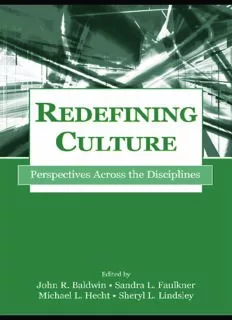
Redefining Culture: Perspectives Across the Disciplines (Lea's Communication Series) (Lea's Communication Series) PDF
Preview Redefining Culture: Perspectives Across the Disciplines (Lea's Communication Series) (Lea's Communication Series)
Redefining Culture Perspectives Across the Disciplines LEA’s COMMUNICATION SERIES Jennings Bryant/Dolf Zillmann, General Editors Selected titles include: Carbaugh: Cultural Communication andInterculturalContact Carbaugh: Cultures in Communication Hecht/Jackson/Ribeau: African American Communication: Exploring Identity and Culture, Second Edition Leeds-Hurwitz: Semiotics and Communication: Signs, Codes, Cultures Leeds-Hurwitz: Wedding as Text: Communicating Cultural Identities Through Ritual For a complete list of titles in LEA’s Communication Series, please contact Lawrence Erlbaum Associates, Publishers at www.erlbaum.com. Redefining Culture Perspectives Across the Disciplines Edited by John R. Baldwin Illinois State University Sandra L. Faulkner Syracuse University Michael L. Hecht The Pennsylvania State University Sheryl L. Lindsley California State University, Stanislaw LAWRENCE ERLBAUM ASSOCIATES, PUBLISHERS 2006 Mahwah, New Jersey London This edition published in the Taylor & Francis e-Library, 2008. “To purchase your own copy of this or any of Taylor & Francis or Routledge’s collection of thousands of eBooks please go to www.eBookstore.tandf.co.uk.” Copyright © 2006 by Lawrence Erlbaum Associates, Inc. Allrightsreserved.Nopartofthisbookmaybereproducedinany form,byphotostat,microform,retrievalsystem,oranyothermeans, without prior written permission of the publisher. Lawrence Erlbaum Associates, Inc., Publishers 10 Industrial Avenue Mahwah, New Jersey 07430 www.erlbaum.com Library of Congress Cataloging-in-Publication Data Redefiningculture:conceptualizingcultureacrossdisciplines/JohnR. Baldwin...[et al.] p. cm.—(LEA's communication series) Includes bibliographical references and index. ISBN 0-8058-4235-7 (cloth :alk. paper) ISBN 0-8058-4236-5 (pbk. :alk. paper) 1.Culture. 2.Culture—Studyandteaching. I.Baldwin,JohnR.,1960– II.Series. HM621.R425 2005 306'.01—dc22 2004059640 CIP ISBN 1-4106-1700-9 Master e-book ISBN Dedicated to the memory of SherylL. Lindsley friend, colleague, and promoter of cultural understanding This page intentionally left blank Contents Foreword: Defining Culture ix RenatoI.Rosaldo Preface xv About the Authors xix Part I: (Re)Considering Contemporary Definitions of Culture 1 A Moving Target: The Illusive Definition of Culture John R. Baldwin, Sandra L. Faulkner, and Michael L.Hecht 3 2 Layers of Meaning: An Analysis of Definitions of Culture Sandra L. Faulkner, John R. Baldwin,SherylL.Lindsley, 27 and Michael L.Hecht 3 The (In)Conclusion of the Matter: Shifting Signs and Models of Culture Michael L.Hecht, John R. Baldwin, and Sandra L. Faulkner 53 Part II: Views of Culture From Across the Disciplines 4 The “Cultures” of Cultural Studies 77 MichaelBérubé vii viii CONTENTS 5 Culture and Behavior: An Approach Taken in Psychology 83 and International Business Richard W.Brislin 6 Communicating Culture 91 JenniferFortmanand Howard Giles 7 Conceptualizing Culture in Education: Implications 103 for Schooling in a Culturally Diverse Society ShernazB.Garcíaand Patricia L.Guerra 8 Narratives on Culture: FromSocio-semioticsto Globalization 117 NéstorGarcíaCanclini 9 Political Culture 127 RonaldInglehart Part III: Definitions of Culture Selected From Across Disciplines Definitions of Culture 139 Definitions References 227 Definitions Index by Category 229 References 239 Author Index 243 Subject Index 253 Foreword: Defining Culture Renato I. Rosaldo New York University & State College, PA The present collection updates Alfred Kroeber and Clyde Kluckhohn’s (1952)Culture:ACriticalReviewofConceptsandDefinitions,avolumethat makesthereadermarvel,even50yearsafteritspublication.Kroeberand Kluckhohn’shistoricalandcomparativecompilationofdefinitionsofcul- tureismajestic.Itencompassesdistinctacademicdisciplines,nationaltra- ditions,andhistoricalperiods.Thevolumebeginsbyconfidentlyasserting that“fewintellectualswillchallengethestatementthattheideaofculture, inthetechnicalanthropologicalsense,isoneofthekeynotionsofcontem- poraryAmericanthought”(p.3). KroeberandKluckhohn(1952)arguedthatthebasicideaofculture— that different nations operate with different categories, assumptions, and moralities—isancientandcanbefoundintheBible,Homer,Hippocrates, Herodotus,andChinesescholarsoftheHandynasty.Keytotheancientand enduringconceptofcultureistherelativelymodest,yetenormouslyconse- quentialdoctrinethatifpeoplethinkandfeeldifferentlyabouttheworld, theyarenotdementedorstupid.Instead,theysimplyaremakingdifferent assumptionsandusingdifferentcategoriestomakesenseoftheworldthey inhabit and find meaning in it. FormostAmericananthropologistsfromthe1930s throughthe1960s, culturewastheprimaryobjectofstudy.Onecouldsay,forexample,“Iam studyingculture”or“IamstudyingBalineseculture.”Anthropologybyand large accepted a definition of culture based on the legacy of German thought,mostcommonlyattributedinitsoriginstoJohannGottfriedvon Herder (1744–1803), combined with that of the historically more recent ix
Description: